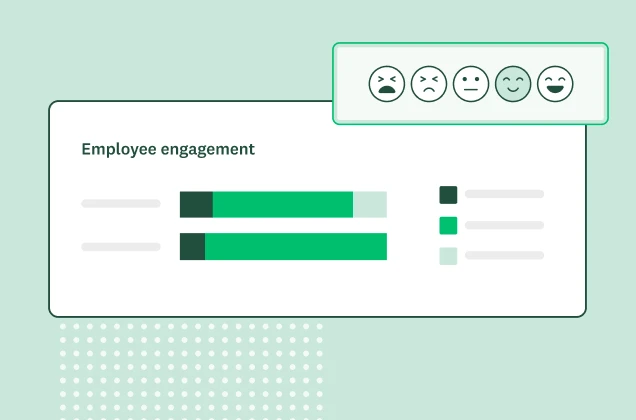Rethinking the workplace: Engaging employees post-COVID
The global COVID-19 pandemic has dramatically altered the world in more ways than one. The workplace is one setting that has witnessed unexpected transformation, with many companies forced to make an unexpected shift from working at the office to suddenly working from home. With vaccines now more readily available and restrictions on social distancing starting to be lifted, the conversation is turning to the post-pandemic workplace, with both employers and employees understandably anxious about how best to facilitate the return to work.
In this article, we’ll look at how to gather data to answer some of the biggest questions on our minds, such as: how can we promote positive communication with workers, whether they come back to the office or continue to work from home? And how can we keep employees engaged and satisfied post-COVID?
Measuring employee engagement
Employee engagement is one of the top ways to measure workforce health and happiness. Engaged workers are: committed to their jobs and to their employers; emotionally invested in the company and its success; willing to go the extra mile; curious and innovative; and dedicated to helping you reach your goals. In contrast, disengaged workers are likely to do the bare minimum: they might be unwilling to help others, are more likely to have intentions to quit in the next 12 months, and may be generally demotivated. Worse, there is a third category of workers: the actively disengaged. These employees are not just lacking in focus and motivation—they may actively take steps to undermine their coworkers' efforts, and thus your ability to achieve your objectives.
Clearly, one of the keys to business success is ensuring that your employees are fully engaged. Although there’s no evidence to suggest that workers are being actively disengaged as a result of the pandemic, some employees have voiced concerns and anxieties about post-COVID working practices, such as whether or not they will be required to return to the office or continue to work remotely, and how to work effectively in dispersed teams. Others may have altered views about aspects such as their work-life balance and workplace wellbeing after over a year of working from home.
As we’ve already noted above, employee engagement is a core business metric that you should be tracking regularly. In a post-COVID world, this is especially important, though, because you’ll be able to determine whether and how policies and practices you’ve implemented are impacting your workers. For example, let’s say as a result of your new experience with managing a remote workforce, you implement a post-COVID policy that allows everyone to work from home on Fridays. By gathering employee engagement data before and after the change, you’ll be able to determine whether the new policy is motivating your workers or not.
For these reasons, it's important to measure the engagement of your workforce, both in preparation for designing the post-pandemic workplace, and at regular intervals (such as annually or every six months) to track any changes, allowing you to take swift, corrective action.
How to measure employee engagement
So, how should you measure employee engagement? You have a range of different options available to you:
- Focus groups are essentially a form of group interview, ideal for research contexts where the participants are located in the same area, such as at the same worksite, department or branch of your business. Typically made up of between 8 and 15 participants, a focus group will come together to discuss and provide insight into a topic of concern. Since you’re collecting data from several research participants at the same time, focus groups are highly efficient and cost effective. Focus groups are also especially insightful where the topic of inquiry is interesting or controversial and therefore likely to provoke lively discussion, making it suitable to gather data on employee engagement. However, there are some drawbacks to consider. While in-person data collection methods like focus groups can be valuable to learning more about whether or not your employees are engaged, they can be challenging to implement. This is especially true in current times, when your workforce might be partially or fully remote, or where gathering groups of individuals might not be feasible. If you have some particularly lively participants, this may prevent some attendees from sharing their experiences and opinions, so focus groups will need to be managed carefully. Also, if the topic of discussion is of a sensitive nature, focus group attendees may be reluctant to share their experiences in a group setting. So, if you have an inkling that there are some sensitive issues affecting engagement, focus groups are probably best avoided.
- Surveys. A survey of your existing employees is another possibility. Many employees are less likely to give you honest insight into their feelings and experiences if you ask them face-to-face. A survey can be developed and administered quickly and anonymously online to a geographically dispersed group of workers, putting you in the best possible position to gather valid, comprehensive data from as many employees as possible. Furthermore, insights can be automated. One of the things we’ve all learned from the pandemic is that time is precious. Not only can you quickly re-administer a standardized employee engagement survey to your preferred time cycle, but, if you use our SurveyMonkey Enterprise solution, you can automate deployments and easily compare results between different time periods. Ready to start? We’ve made the process easy, with templates like these on hand to get you started on measuring employee engagement.
- Exit interviews. It's not only your existing employees that are the source of insightful data on engagement. Those that are on their way to pastures new may also have some critical feedback to share, so holding exit interviews is something you should make a habit of, even if employees are leaving for personal reasons. A good way to begin is by asking the individual what they’re looking for in their next role. This will help you gauge whether they’re looking for something your company hasn’t been able to provide. By asking the leaving employee for suggestions on how your business can improve, or what their next company is offering, you’ll also be able to capture rich insight that can feed directly into your policies and practices. Some interviewees may feel self-conscious about offering criticism, however, and in that case, you might wish to consider following up the interview with a written survey.
Employee satisfaction
When employees are satisfied, they believe that their needs, wishes, and expectations from their work and from their employer are being met. Decades of research has established that job satisfaction is a key driver of a host of positive employee and organizational outcomes, including high levels of employee commitment and engagement, low levels of turnover, high productivity, and high performance. It makes sense, then, to try to cultivate high levels of satisfaction in your workers through your policies, practices, and procedures.
There is a good chance that if your workers are engaged, they’re also satisfied. However, although employee engagement and employee satisfaction often go hand in hand, that’s not always the case. That’s because satisfaction is usually understood as a multidimensional construct, comprised of different elements related to the job. It is possible, for instance, for an individual to be satisfied with certain aspects of their job (e.g. their level of responsibility) but to express a low level of satisfaction with other aspects (such as their pay). Of course, in the post-COVID workplace, many aspects of employment may change, such as your paid time off policy or your expectations around remote working. It's crucial to understand your workers’ responses to these changes, and whether or not those changes are contributing to overall employee wellbeing. That’s why we recommend measuring employee satisfaction in addition to measuring employee engagement.
How to measure employee satisfaction
Like employee engagement, employee satisfaction can be measured through a number of different approaches.
- Surveys. These have long been the standard for capturing employee satisfaction data. Since employee satisfaction should be measured on a continuum of low to high, you should ask questions that measure the degree of satisfaction, rather than questions that can be only answered with a yes or no response. For example, using a Likert approach, you might ask respondents to indicate how satisfied they are with their jobs on a scale from 1 to 10. Alternatively using a semantic differential scale, dichotomous labels are placed at either end of a spectrum, and respondents are asked to indicate where they sit on the scale. You might, for instance, use a slider scale, with ‘highly dissatisfied’ and ‘highly satisfied’ placed on the left and right anchors respectively. In terms of survey design and administration, there are two different ways you might want to think about.
- A single survey approach. Using this method, a single survey is used to measure different dimensions of satisfaction, like employees’ satisfaction with the company’s approach to inclusion and belonging, their compensation and benefits, or their task variety. If you use this method, you would divide the survey into dedicated sections. At the analysis stage, results can be combined into an overall measure of employee satisfaction.
- A specific factor approach. Using this method, a survey approach is used to gather data on a specific dimension of satisfaction, like the career development prospects or the pay package. This approach is especially useful if you make a change to employment policies as a result of the pandemic, because you can quickly determine whether employees are satisfied with the change—and to what degree—rather than evaluating satisfaction as a whole, which could mask the impact of that change.
For more information about how to measure employee satisfaction, and the kinds of questions you might want to ask on your survey, click here.
- Annual performance reviews. Annual performance reviews are not just about evaluating employee achievements, and making decisions about rewards: they’re also a great source of insight into how satisfied employees are. The review should be designed to give employees a space to share their own experiences and reflections on the previous year, and you should make it a habit to ask them about their satisfaction. When a review is conducted face-to-face, employees may feel empowered to voice their personal opinions. Another benefit of this approach is that it conveys the message to employees that you value their feedback enough to ask for their insight. However, just because you’ve carved out an annual space to collect this kind of feedback, you shouldn’t ignore other opportunities too. Holding regular check-ins with your direct reports is the best way to gather information about morale and dissatisfaction, enabling you to diagnose problems quickly, and tackle them as they arise.
- Employee Net Promoter Score. Based on the traditional Net Promoter Score, the employee Net Promoter Score (eNPS) is a simple system you can use to assess how satisfied your workforce is. In fact, it’s so simple that it only involves two questions.
- The first question is a rating question that asks employees to rate, on a 10-point scale: How likely are you to recommend [company name] to your family and friends as a place to work?
- The second question is an open-ended follow up question, which asks employees to explain why they chose the rating that they did. Using the answers to both questions together, you can glean some deep insight into employee satisfaction. You first do this by sorting responses into three categories based on the answers to the first question:
- Promoters are satisfied employees who selected a score of 9 or 10.
- Passives are employees who chose a rating of 7 or 8. These employees are content, but perhaps not actively engaged.
- Detractors selected ratings of 6 or below. Since these individuals are less likely to recommend you as a place to work, they are likely to be dissatisfied in some way or another.
You should pay careful attention to the feedback provided by all three categories of employees (not just the detractors!) to learn more about the source of employee satisfaction and dissatisfaction. You should also calculate an overall eNPS score by subtracting the percentage of detractors from the percentage of promoters. Overall eNPS scores can range from -100 (all employees are detractors) to +100 (all employees are promoters). By administering the eNPS survey on a regular basis, you can track trends in satisfaction over time.
Employee experience
Another aspect of employee wellbeing is employee experience. Employee engagement and satisfaction both measure psychological or emotional states, while employee experience measures what your workers observe and encounter during their employment. This can encompass a wide range of experiences, beginning from the very first day that your employees walk through the door.
In addition, both formal and informal experiences can be evaluated and measured. For example, employee experience can be used to capture assessments of the onboarding process, opportunities for training and development, and policies regarding time off. It can also be used to evaluate employee perceptions of the organizational culture, support from their supervisors and team mates, and their sense of belonging at the company—all aspects which may have changed as a consequence of new ways of working under the pandemic.
It is especially important to measure employee experience because research shows that there is a strong link between employee experience and employee turnover. Put simply, if your workers have a poor experience at work, they’re more likely to quit.
To measure employee experience, we recommend focusing on the following elements:
Employee recognition
It's vital that employees are recognized for their efforts. Employees that feel recognized perceive that they matter to the company, and that they make a valuable contribution to the pursuit of its goals. Recognition can take the form of a mere pat on the back, or may be formalized through the benefits and rewards system. However, new forms of working, and especially remote working, may make employees feel a greater sense of disconnect from the company, and recognition may be more difficult to practice. Asking employees directly in your survey about the degree to which they feel recognized will be crucial to ensuring an engaged, committed workforce in the post-pandemic workplace.
Employee onboarding
Onboarding of new members of staff may also look very different in a post-pandemic world. The key function of the onboarding process is to socialize new employees to their new working environment and their new roles. It is at this stage that you will demonstrate to new hires what is expected of them in terms of productivity and engagement with their team members. However, in hybrid and remote workplaces, it might be more challenging to acclimate new hires to their roles, and to help them feel welcomed and supported. Surveying employees on your onboarding practices will help you identify where there are areas that are not working as effectively as they could.
Employee training
Finally, after a year’s absence from the office, there may be new training needs which you have overlooked. For instance, some workers may need training on how to communicate and work effectively in dispersed teams, or on how to use digital body language in video meetings. You won’t know exactly what your workers need unless you ask them. Insight into training needs and other crucial factors can be gleaned through return to work assessment surveys. For more on SurveyMonkey’s return to work surveys, see our dedicated solutions.
Employee communication
Whether they’re working remotely or returning to the office, establishing and maintaining good communication with employees is vital to keeping them engaged, motivated and committed. The true intent of messages can be lost in impersonal communications (like on Slack), and many workers will find it difficult to readjust to the new normal. To ensure that communication doesn’t suffer in the post-pandemic workplace, follow these tips:
- Show empathy and open dialogue. Both employees that are returning to the office, or those that are going remote full-time are likely to experience learning curves relating to new communication practices and even the use of new technologies (so-called technostress is now a recognized form of stress!). Show empathy to employees during this transition period, and make it clear that you are available to discuss any concerns that they might have.
- Manage expectations. At the same time, it is important to manage expectations. One of the challenges in working from home is in boundary setting. Remote workers might find it difficult to separate their working lives from their home lives; alternatively, some might shirk from their duties. Oftentimes, the problem can be solved by communicating expectations about work times, work-life balance, and time away from the desk.
- Use fun to grow personal connections. Many workers who transition from life in the office to life at home say that they miss the social connections with their colleagues. This is an important point: colleagues that feel a personal connection with one another are more likely to work together effectively to achieve team goals. Regular team-building events can help fill the gap of in-person interactions. For example, you might want to encourage workers to hold video coffee dates with one another, or facilitate virtual events like trivia nights or “away days.”
Corporate office redesign
There can be no doubt that the pandemic is changing the way that offices are designed. In direct response to the health issues raised by the pandemic, as well as experiences working from home, there is greater demand than ever before for office spaces that are well ventilated, allow natural light, and enable workers to enjoy private space, while also building team connections and focusing on wellness and comfort. You may wish to think about investing in green spaces or privacy booths in response to these changing needs. However, before you invest in redesign to help employees feel safe in the post-COVID office, make sure you capture their feedback first.
Remote employees
However you redesign your working space, remember that the trend of employees working remotely is unlikely to disappear in the post-COVID world. According to some recent research with Microsoft, around 71% of employees want the flexibility of working from home to continue post-pandemic. If you want to keep employees engaged, it will be important to capture their feelings on this issue and respond appropriately. If feasible for your business, this might involve allowing remote workers to stay home indefinitely, or creating new hybrid work environments.
Employees returning to work
On the other hand, if you do think it's important for employees to return to offices and in-person work environments, there are steps that companies should take to ensure their employees feel comfortable, safe, and engaged at their place of work. If there are still concerns about the coronavirus, you might want to consider changing the physical location of workstations to allow employees to keep a safe distance from one another. Other strategies include regular access to testing and signposting services for psychological wellness and physical health.
As you can see, the post-COVID workplace is likely to be very different from the old normal. Measuring employee engagement is a great way to ensure that your workers are not affected negatively. Start by using SurveyMonkey’s return to work solutions to ensure that your employee engagement strategy is ready for a post-COVID work environment.
Discover more resources

Human Resources Leader
HR leaders can use this toolkit to help drive exceptional employee experiences.

Get the employee information you need with online employment forms
Hire top talent, speed up the onboarding process and manage your workforce with a custom employment form. Start creating forms today with our employment form builder and templates.

Get feedback you can act on with online evaluation forms
Unlock the power of feedback with SurveyMonkey's online evaluation forms. Start with our form builder today!

How to make a quiz online: Examples, tips, and best practices
Make a quiz online by following these 10 steps. Following these tips will take you from scratch to having a fully functioning online quiz.